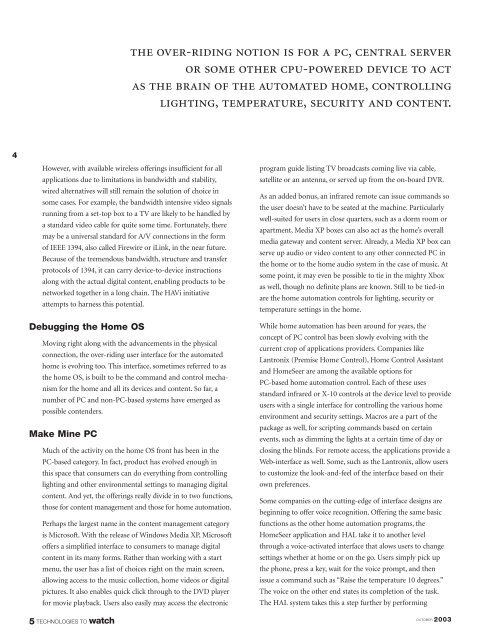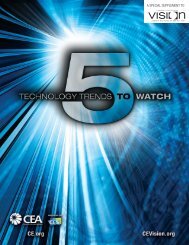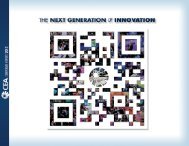TECHNOLOGIES TO watch - Consumer Electronics Association
TECHNOLOGIES TO watch - Consumer Electronics Association
TECHNOLOGIES TO watch - Consumer Electronics Association
You also want an ePaper? Increase the reach of your titles
YUMPU automatically turns print PDFs into web optimized ePapers that Google loves.
THE OVER-RIDING NOTION IS FOR A PC, CENTRAL SERVEROR SOME OTHER CPU-POWERED DEVICE <strong>TO</strong> ACTAS THE BRAIN OF THE AU<strong>TO</strong>MATED HOME, CONTROLLINGLIGHTING, TEMPERATURE, SECURITY AND CONTENT.4However, with available wireless offerings insufficient for allapplications due to limitations in bandwidth and stability,wired alternatives will still remain the solution of choice insome cases. For example, the bandwidth intensive video signalsrunning from a set-top box to a TV are likely to be handled bya standard video cable for quite some time. Fortunately, theremay be a universal standard for A/V connections in the formof IEEE 1394, also called Firewire or iLink, in the near future.Because of the tremendous bandwidth, structure and transferprotocols of 1394, it can carry device-to-device instructionsalong with the actual digital content, enabling products to benetworked together in a long chain. The HAVi initiativeattempts to harness this potential.Debugging the Home OSMoving right along with the advancements in the physicalconnection, the over-riding user interface for the automatedhome is evolving too. This interface, sometimes referred to asthe home OS, is built to be the command and control mechanismfor the home and all its devices and content. So far, anumber of PC and non-PC-based systems have emerged aspossible contenders.Make Mine PCMuch of the activity on the home OS front has been in thePC-based category. In fact, product has evolved enough inthis space that consumers can do everything from controllinglighting and other environmental settings to managing digitalcontent. And yet, the offerings really divide in to two functions,those for content management and those for home automation.Perhaps the largest name in the content management categoryis Microsoft. With the release of Windows Media XP, Microsoftoffers a simplified interface to consumers to manage digitalcontent in its many forms. Rather than working with a startmenu, the user has a list of choices right on the main screen,allowing access to the music collection, home videos or digitalpictures. It also enables quick click through to the DVD playerfor movie playback. Users also easily may access the electronicprogram guide listing TV broadcasts coming live via cable,satellite or an antenna, or served up from the on-board DVR.As an added bonus, an infrared remote can issue commands sothe user doesn’t have to be seated at the machine. Particularlywell-suited for users in close quarters, such as a dorm room orapartment, Media XP boxes can also act as the home’s overallmedia gateway and content server. Already, a Media XP box canserve up audio or video content to any other connected PC inthe home or to the home audio system in the case of music. Atsome point, it may even be possible to tie in the mighty Xboxas well, though no definite plans are known. Still to be tied-inare the home automation controls for lighting, security ortemperature settings in the home.While home automation has been around for years, theconcept of PC control has been slowly evolving with thecurrent crop of applications providers. Companies likeLantronix (Premise Home Control), Home Control Assistantand HomeSeer are among the available options forPC-based home automation control. Each of these usesstandard infrared or X-10 controls at the device level to provideusers with a single interface for controlling the various homeenvironment and security settings. Macros are a part of thepackage as well, for scripting commands based on certainevents, such as dimming the lights at a certain time of day orclosing the blinds. For remote access, the applications provide aWeb-interface as well. Some, such as the Lantronix, allow usersto customize the look-and-feel of the interface based on theirown preferences.Some companies on the cutting-edge of interface designs arebeginning to offer voice recognition. Offering the same basicfunctions as the other home automation programs, theHomeSeer application and HAL take it to another levelthrough a voice-activated interface that alows users to changesettings whether at home or on the go. Users simply pick upthe phone, press a key, wait for the voice prompt, and thenissue a command such as “Raise the temperature 10 degrees.”The voice on the other end states its completion of the task.The HAL system takes this a step further by performing5 <strong>TECHNOLOGIES</strong> <strong>TO</strong> <strong>watch</strong>OC<strong>TO</strong>BER 2003










